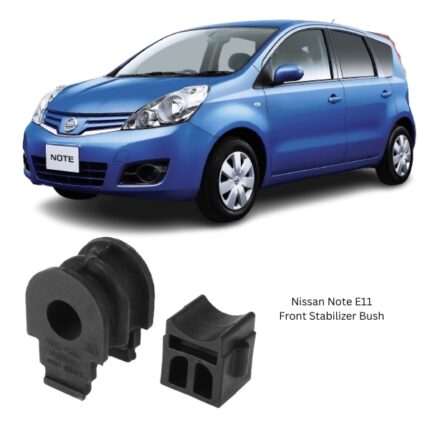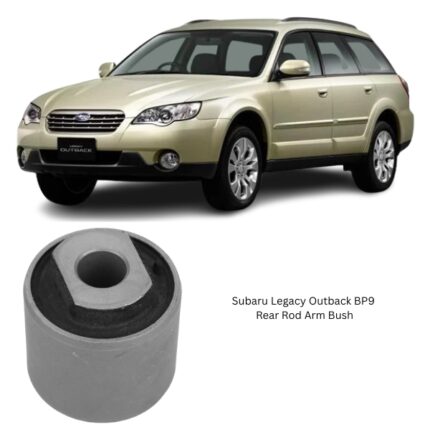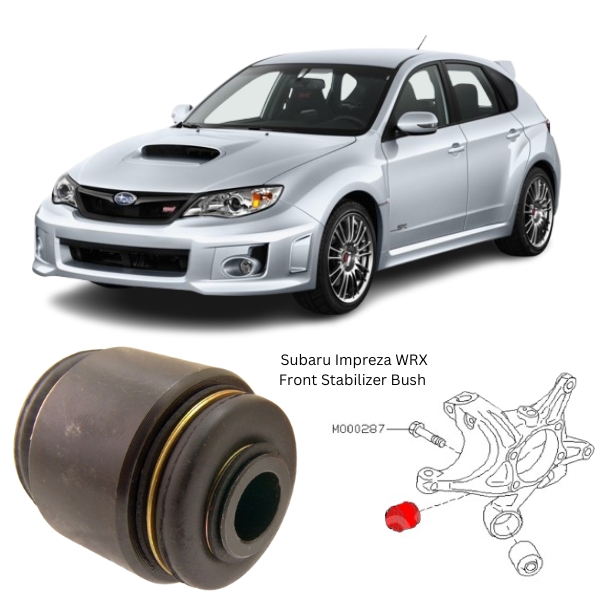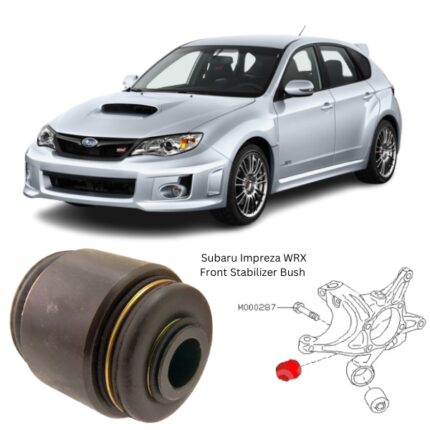Get Subaru Impreza WRX Front Stabilizer Bush 20257-XA000 in Kenya
The front stabilizer bush, also commonly referred to as the front sway bar bush or anti-roll bar bush, is a crucial component in a vehicle’s suspension system. Despite its small size and simple design, this rubber or polyurethane bushing plays a significant role in enhancing driving stability, minimizing body roll, and improving vehicle handling—especially when navigating turns, uneven terrain, or sudden maneuvers. Mounted at fixed points between the front stabilizer bar and the vehicle’s chassis or subframe, this bushing ensures smooth and controlled articulation of the stabilizer bar while reducing noise, vibrations, and wear.
1. Primary Function of the Front Stabilizer Bush
The front stabilizer bush serves as a pivot and cushion for the stabilizer bar (also known as the anti-roll bar). The stabilizer bar links the left and right sides of the suspension to help reduce body roll during cornering. As the vehicle turns or moves over uneven road surfaces, the stabilizer bar twists to balance the suspension load between the left and right wheels.
The stabilizer bush allows the bar to rotate or flex freely while keeping it firmly mounted to the chassis. Its main functions include:
-
Securing the stabilizer bar in place
-
Allowing controlled twisting motion of the bar
-
Isolating metal components to prevent contact and friction
-
Absorbing vibrations and reducing road noise
-
Helping stabilize vehicle body motion during turns
Without a properly functioning front stabilizer bush, the stabilizer bar would not be able to operate effectively, resulting in poor handling and reduced ride quality.
2. Location and Installation Points
The front stabilizer bush is located beneath the vehicle, typically near the center portion of the front stabilizer bar. It is usually housed inside a clamp bracket or saddle and bolted to the front subframe or chassis of the vehicle. Most vehicles are equipped with two front stabilizer bushes—one on the right side and one on the left side of the bar.
The bush wraps around the stabilizer bar, allowing it to pivot during suspension articulation while keeping it centered and restrained.
3. Design Characteristics
The front stabilizer bush is engineered to be both flexible and durable. Key design features include:
-
Semi-circular or cylindrical shape: To wrap snugly around the stabilizer bar.
-
Split or slotted design: Allows easy fitment around the bar without removing other suspension components.
-
Inner grooves or lubrication channels: Reduce friction and allow smoother rotation of the stabilizer bar.
-
Compression fit with bracket: Ensures a tight grip when the retaining clamp is fastened.
In many cases, the bushing is designed to slightly compress when installed, maintaining constant pressure on the stabilizer bar to prevent rattle or free movement.
4. Materials Used
Stabilizer bushes are subjected to extreme conditions, including heat, dirt, moisture, mechanical stress, and constant vibration. To withstand these elements, they are made from durable, resilient materials such as:
a) Natural Rubber
-
Excellent flexibility and shock absorption.
-
Common in standard vehicles for comfortable ride quality.
-
Cost-effective but prone to degradation over time due to weather, oil, and road chemicals.
b) Polyurethane
-
Firmer and more durable than rubber.
-
Ideal for high-performance, off-road, or heavy-duty applications.
-
Resistant to oil, chemicals, ozone, and UV radiation.
-
Provides sharper handling, but may transmit slightly more road vibration.
c) Synthetic Elastomers
-
Offers a balance of durability and comfort.
-
Found in newer models for improved heat and wear resistance.
The choice between rubber and polyurethane depends on the driver’s preferences and the intended use of the vehicle. Rubber favors comfort, while polyurethane favors performance and durability.
5. How the Front Stabilizer Bush Works
During cornering or uneven road contact, the front wheels may move up and down at different rates. This causes the stabilizer bar to twist. The front stabilizer bush allows the bar to pivot and flex freely while holding it firmly in place. The movement is limited and controlled, allowing the bar to perform its function of transferring force and minimizing chassis roll.
For example:
-
During a left turn, the body leans to the right.
-
The stabilizer bar transfers force from the right wheel to the left, resisting this lean.
-
The bush allows this twisting movement while minimizing noise and maintaining bar alignment.
This small but essential component ensures that the bar operates quietly, efficiently, and with minimal wear to surrounding components.
6. Signs of a Worn Front Stabilizer Bush
As with most rubber or flexible components, stabilizer bushes wear out over time due to:
-
Heat cycles
-
Friction and movement
-
Exposure to water, salt, and oil
-
Physical stress from bumps and cornering
Common symptoms of a worn or failing front stabilizer bush include:
a) Clunking or knocking noises
-
Especially noticeable when driving over speed bumps or rough roads.
-
Caused by excess play between the stabilizer bar and the chassis mount.
b) Increased body roll
-
The vehicle may feel less stable during turns or when swerving.
-
Resulting from reduced resistance from the stabilizer system.
c) Poor steering response
-
Looseness or vagueness in the front end handling.
-
Common in vehicles with degraded or deformed bushes.
d) Uneven tire wear
-
Caused by imbalanced suspension geometry due to poor stabilizer control.
e) Visible cracks, splits, or hardening
-
Upon inspection, worn bushes may appear dried out, cracked, or loose inside their brackets.
Prompt replacement of worn bushes prevents further suspension damage and restores ride quality.
7. Inspection and Diagnosis
Checking front stabilizer bushes is a routine part of suspension maintenance. Inspection includes:
-
Visual Check: Look for cracks, gaps, or deformation.
-
Manual Movement Test: Move the stabilizer bar with a pry bar; excess movement may indicate worn bushes.
-
Noise Test: Drive over bumps or take tight turns to listen for rattles or thuds.
Bushes should always be checked in pairs—if one side is worn, the other is likely to be close behind.
8. Replacement Procedure
Replacing the front stabilizer bush is relatively straightforward for most vehicles:
-
Lift the Vehicle Safely: Ensure it’s securely supported on jack stands.
-
Locate the Bushes: Identify both bushes mounted on the stabilizer bar.
-
Remove the Brackets: Unscrew the bolts holding the bush clamps to the chassis.
-
Remove the Old Bush: Slide or peel it off the stabilizer bar.
-
Install the New Bush: Wrap the new bush around the bar, aligning it correctly.
-
Reattach the Bracket: Bolt the clamp back in place and torque to specification.
If replacing with polyurethane bushes, some may require lubrication to prevent squeaking. It’s best to replace both front bushes simultaneously to maintain symmetrical suspension performance.
9. Maintenance and Longevity
The lifespan of a front stabilizer bush varies depending on usage, road conditions, and material type. Generally:
-
Rubber bushes last between 50,000–100,000 km.
-
Polyurethane bushes can last much longer, often the life of the vehicle with minimal degradation.
To prolong bush life:
-
Avoid harsh chemicals near suspension components.
-
Keep undercarriage clean and protected.
-
Inspect suspension regularly for wear or looseness.
-
Use high-quality replacement parts matched to your vehicle’s needs.
10. Contribution to Safety and Performance
The front stabilizer bush is fundamental to vehicle safety and handling. It plays an essential role in:
-
Minimizing body roll for safer and more confident cornering.
-
Improving vehicle responsiveness and stability.
-
Isolating suspension noise for a quieter ride.
-
Extending lifespan of other components such as control arms and sway bars.
-
Enhancing comfort by reducing harsh feedback from the road.
Even though it’s often hidden and overlooked, its absence or malfunction would drastically impact how a vehicle drives and feels.
Follow us on Facebook for more parts.





Reviews
Clear filtersThere are no reviews yet.